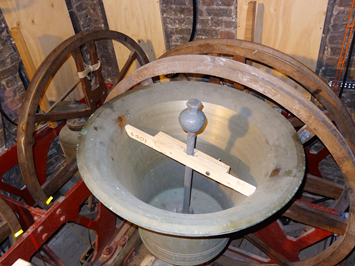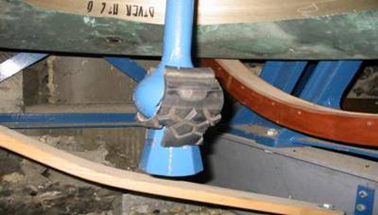Silencing a bell
Equipment used to silence a bell should only be fitted or removed when the bells are in the 'down' position (never when the bells are up). They should be fitted securely to ensure that they do not slip around during the ringing. Always work in the bell chamber with someone else. If lone working cannot be avoided, take a mobile phone with you and let someone else know that you are working on the bells and how long this work should take. For the most up to date advice, refer to the CCCBR website.

Hinged wooden clamp

Motorcycle tyre

Bicycle inner tube
Hinged wooden clamps
Hinged wooden clamps, secured to the bell with a wing nut locking mechanism, can clamp the clapper in the centre of the bell and are easy to make. These can sometimes work loose if not tightened properly and need to be tailored to fit the diameter of each bell. One disadvantage of clamping the clapper centrally is that it makes the bell lighter set on both strokes, as the weight of the clapper is not working so effectively at holding the bell on the stay.
Motor-cycle tyres
An alternative method is to cut an old motor-cycle tyre into sections. Old tyres are easy to get hold of as garages need to dispose of them and they produce a heavily muffled sound on both strokes. Being fixed to the clapper means that they do not affect the set of the bell.
Bicycle inner tubes
Bicycle inner tubes act as a large rubber band and can be used to hold the clapper centrally or to one side. They are relatively cheap and quick to fit and remove, the top end being looped over one of the nuts on the headstock. If the tube is too long, you can shorten it by tying a simple knot in the middle of the tube.
Rope
Position yourself comfortably on one side of the bell. Pass one end of the rope around the top of the bell under the headstock making a loop. Tie a packer’s knot where shown. And pull reasonably tight. Twist the loop round so that the long end of the rope hangs down on the far side of the bell.
Reach under the bell and pull the loose end of rope fairly taut against the middle of the far side of the lip of the bell. Then tie a clove-hitch around the narrow part of the flight as shown. With practice you can make the knot and then slip it over the flight. Adjust if necessary so that the clapper is about in the middle of the bell and pull tight.
Bring the loose end of the rope to your side of the bell and pass the end through the loop that you made at the beginning. Pull the rope towards you very tightly. Secure it with two half hitches. Tuck in any loose rope securely.
» Setting up your simulator